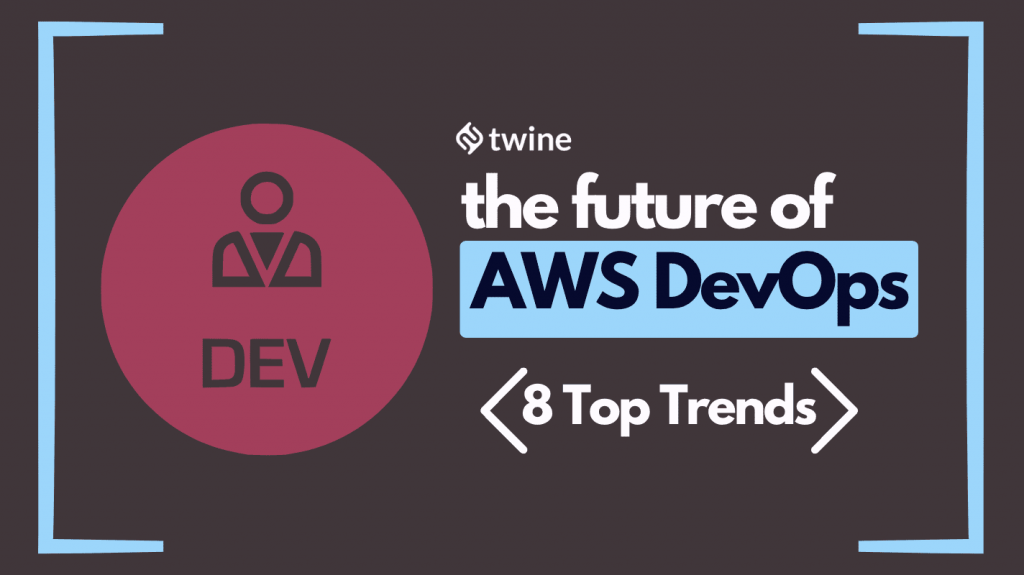
For more Web Tools, check out the Freelancer Toolkit…
In recent years, many new technologies and practices have seen widespread adoption across industries. In the fast-paced business environment of the 21st century, transformational systems like AWS DevOps have taken center stage.
Why?
Because of their ability to disrupt industries. In software development today, DevOps are indispensable.
In this article, we’ll examine the most emergent trends when it comes to DevOps and AWS.
Are you a talented AWS Developer? Browse jobs and opportunities here at Twine…
How AWS DevOps is Powering the World…

Already, AWS DevOps has begun changing how companies do business.
AWS includes flexible services that help companies quickly create and deliver products.
DevOps is a mix of development philosophies, practices, and tools combined to make it easy for businesses to build applications and render services at a faster pace than traditional software development.
Often, these practices are seen in the IT and software development industry. However, software from other areas, such as healthcare, can also benefit from DevOps.
For example, as patients expect communication to be quick and convenient, dental companies can use CI/CD pipelines to integrate appointment confirmations, payment reminders, follow-up texts, and self-scheduling features into their existing admin systems.
Speed, efficiency, and service are at the core of DevOps practices. With AWS DevOps, you get all of the benefits from AWS services, plus the best of DevOps practices.
This means your company can simplify managing infrastructure, streamline deploying application code, automate your software release process, and monitor how your applications and infrastructure perform.
Now that you know a bit more about how AWS DevOps functions, and how it is changing the face of software development, we’ll look at how DevOps is continuing to evolve to meet the needs of businesses.
Trends on the Horizon

Because DevOps works primarily as a system for providing the means to solve a problem, it integrates well with other frameworks.
This also means that DevOps is well-suited to adopting new technologies. This next section will examine how new technologies and practices are shaping AWS DevOps.
Serverless Computing
Teams and companies utilizing DevOps are seeing an increase in the use of serverless architecture. Utilizing server architecture requires massive amounts of capital, and can become expensive due to the operational costs.
For example, some of the largest data centers can use up to 100 MW of power. Shifting to serverless architecture doesn’t eliminate the need for data centers, but, it does eliminate the need for your firm to manage its own architecture.
Moving modular components of your development process to serverless architecture has many benefits. One such benefit would be that your team can focus on deploying and developing products, rather than managing a sophisticated group of machines that contains your development process.
A serverless system streamlines your DevOps process, reduces your web developer’s workload, and gives you more flexibility.
Serverless systems will also give you greater reliability and speed and improve your cost-efficiencies.
Microservices Architecture
If you’re familiar with AWS and cloud computing, chances are you’ve heard of microservices. Microservices architecture has steadily been gaining popularity as the go-to architecture for the IT industry.
Through this archetype, computer systems are organized into small discrete segments that can scale themselves on demand. A microservice architecture breaks down software and services and eliminates monolithic projects.
If a piece of software can be viewed like a house, for example, microservices break it down into areas like a kitchen, bedroom, and living room. Depending on your needs, you can break down those services into even smaller parts.
The advantages of a microservices architecture are numerous. If a single piece of your microservices architecture fails, you can quickly identify which component has stopped working.
Microservices also enhance security. Today, IT professionals and security experts increasingly rely on zero trust frameworks in conjunction with microservices.
Zero trust assumes a security breach has occurred, isolates components from one another, and requires the exchange of encrypted communication for any data. If one microservice is breached, for instance, your other microservices will be unreachable. We’ll cover more on security later in the DevSecOps section.
In the end, microservices architecture can give your decentralized teams the ability to innovate rapidly. You can also track performance metrics by measuring individual services.
Low-code/No-code
Today, many new applications and features can be built using low-code/no-code. This is enabled through purpose-built development.
These tools boast drag-and-drop interfaces, pre-built features, and other functions, allowing developers and those without programming experience to build and deploy applications quickly. In today’s fast-paced development world, these tools are essential.
Building applications and services without coding mean that contributors can support all levels of software development, without needing any prior experience. Because it impacts all levels of software development, teams can plan apps, design software, and perform feedback testing, all without writing code themselves.
However, this software doesn’t always allow for trouble-shooting and quick fixes. This is why it’s better to have a developer on-hand and in your team, so small mishaps don’t turn into large, money-losing problems.
DevSecOps
The next stage in DevOps is its transformation into DevSecOps. But what is it?
Enterprises across the globe have begun including automated security into their DevOps processes, but, DevSecOps integrates security straight into DevOps. It’s stated by 2023, the DevOps market will reach $5.9 billion.
The expansion of DevOps means that significantly more companies will embed security controls earlier into the software development process. By introducing security as an essential part of the development process, applications become more secure, and development embraces a security-first mindset.
As part of this process, CI/CD will integrate with new tools and frameworks to enhance security. While new components are built, they can be continuously revised to patch security flaws and make overall development secure.
In the end, DevSecOps embraces all of the advantages of DevOps, but with many added security benefits. This is all without slowing down development or hampering the quality. Neat, right?
Blockchain
In barely a decade, terms like blockchain and cryptocurrency have gone from being unheard of to being almost household terms.
Today, AWS provides functional tools to support an enterprise’s blockchain needs. Blockchain is commonly known as the technology underpinning cryptocurrencies and is used as digital currency for buying and selling goods. It can also be utilized for tracking and tracing products and materials in a supply chain.
Many developers in DevOps will have to familiarize themselves with blockchain technologies as it becomes more ubiquitous. Clients will increasingly require knowledge of blockchain structures, so it’s a useful skill to have.
Infrastructure As Code (IAC)
One important change rapidly becoming more apparent is the utilization of IAC (infrastructure as code).
IAC reorganizes your infrastructure using configuration files, instead of manually setting everything up. This allows you to automatically provision and configure environments without human involvement.
Avoiding human involvement means avoiding human errors. It also means that you can quickly (and easily) change your network’s configuration by changing your code.
Some of the advantages that IAC has include consistency of identical setups, improved productivity during the development cycle, and faster deployment. IAC continues to be a significant aspect of DevOps in 2022. In our next section, we’ll look at how IAC can also support other aspects of DevOps.
Kubernetes and GitOps
AWS makes it easy to run Kubernetes, an open-source container orchestration platform. Kubernetes has emerged as an essential component for operations infrastructure and is expected to expand to the software development space. This means that Kubernetes will become easier for developers to launch and manage on their local machines.
Furthermore, Kubernetes security and IAC mean that you can manage your Kubernetes cluster the same way you would write code. This embeds Kubernetes security and eliminates the need to manage containers individually and manually.
Related to Kubernetes is GitOps.
GitOps is another infrastructure tool that allows developers and IT operators to implement continuous development for cloud-native applications. It then creates a Git repository, that contains declarative descriptions of the infrastructure being used in development.
It also includes automated processes to make the production environment match the respiratory descriptors. GitOps leverages declarative infrastructure as code, which is used for implementation and is designed to integrate with Kubernetes.
Infrastructure tools that improve the organization of your development process will continue to play a huge role in DevOps. Kubernetes and GitOps together create a powerful duo that can manage your infrastructure needs to help build, test, and deliver software quickly.
AI +ML
In the past 10 years, AI (artificial intelligence) and ML (machine learning) have drastically changed how businesses operate.
Companies can utilize AI and ML to analyze vast quantities of data unlike ever before. Sophisticated AI models, trained using datasets, can sort through vast amounts of structured and unstructured data. AWS DevOps seamlessly integrates with AI and ML to make handling files and data even easier.
One area where AI and ML excel is in predictive analytics. When applied to DevOps, AI can analyze code problems and suggest solutions. This will allow you to leverage deep learning, data mining, statistics, and modeling as a business.
Conclusion
AWS DevOps is continuing to evolve and is driving significant changes in AWS and other digital areas.
Embracing new technologies and integrating them into your DevOps architecture can help reduce inefficiencies, improve software delivery, and ensure better software in the long run.
These trends will enhance security and provide developers with more robust tools and frameworks for solving development problems.
Ready to get hired? At Twine, we have dozens of top-quality jobs being posted each and every day. From design to marketing, development to copywriting – there’s a job ready for your skills. Join the marketplace of diverse creative talent here.



